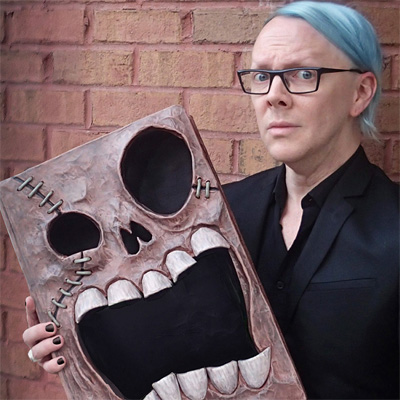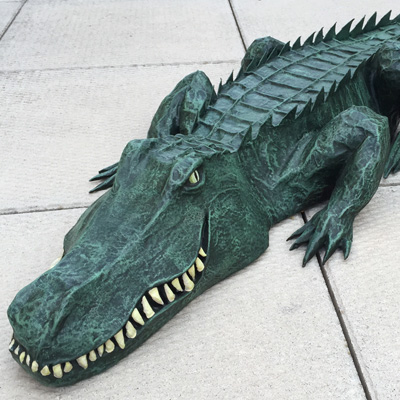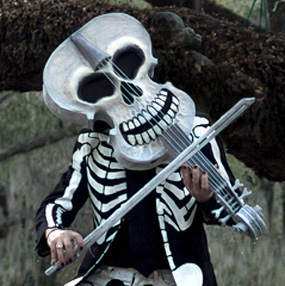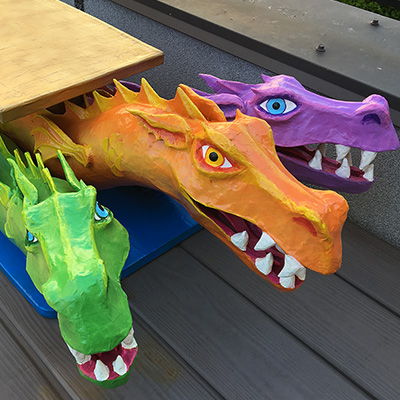Hot glue gun tips!
Published by Manning on June 20th, 2018
For some reason I avoided getting a hot glue gun for years, and when I finally did it kind of changed my life! Now I rely on my hot glue gunS — that’s right, plural — for practically all my creative projects, and some real-life stuff too.
Different sizes
So yeah, I have two hot glue guns, which take different types of hot glue sticks; I use the two different kinds for for different types of tasks.
My first hot glue gun was this CCBetter mini hot glue (paid link); I’ve had it for years, and it’s great!
This one takes 0.27″ diameter glue sticks, like these:
Gorilla hot glue sticks, 4″ long x 0.27″ diameter, 30 count (paid link)
These are the more common size of hot glue sticks; most kinds of hot glue guns use ’em. I go through several packages of these a year. Note: you can buy these kinds of 0.27″-wide sticks that are 4″ long or 8″ long. I almost always buy the shorter ones; the longer ones stick way out the back of the glue gun, and they can really get in the way if you’re working inside a small space where you have to put your whole hand and the glue gun in. However, if you’ve got the longer sticks, it’s easy to just cut ’em in half with scissors before you use ’em.
Anyway, back to the mini glue gun. This size of hot glue gun is good for tasks where I have to reach into small areas, like when I’m working on the interior of a mask, or deep in a narrow corner between two larger spaces. It’s also great for gluing tiny objects together; if you’re careful you can create teeny-tiny blobs of hot glue by pressing the trigger very slowly and lightly.
Other details: This hot glue gun has a little wire stand that’s retractable, so you can fold it up out of the way when you’re working. Some hot glue guns have a stand that doesn’t move, which can really get in the way and prevent you from reaching into small areas. The retractable wire stand is a big advantage.
This hot glue also has an on/off switch, which not all models have. Some hot glue guns are always “on” when they’re plugged in. More on that below.
Anyway, I also have this larger Cobiz heavy duty hot glue gun (paid link).
This one takes wider glue sticks that are 0.43″ in diameter, like these:
Gorilla hot glue sticks, 4″ long x 0.43″ diameter, 45 count (paid link)
Like with the smaller size, I also go through several packages of this size of glue sticks every year.
This heavy duty hot glue gun has two different wattage/heat settings; I had no idea why this mattered ’til I messed around with it and figured it out — it turns out the cooler setting (60-watt) produces hot glue that’s the same gooey/blobby consistency as the mini hot glue gun (but in bigger blobs), whereas the hotter setting (100-watt) produces hot glue that’s much more liquid-y; it can drip and run in a way that the other setting doesn’t allow. This can be a good thing if you’re planning for it! But it can be a bad thing if you’re not expecting it — you go to apply the glue in a specific place and it runs down from where you’re trying to put it.
This heavy duty glue gun is good for larger tasks where I need a lot of strength and there’s enough space for really big blobs of glue. It shoots the glue out much faster and in much bigger quantities than the mini hot glue gun.
Some examples of tasks I use this hot glue gun for: Gluing a hard hat into a mask. Securing a big shape after gluing it down by creating a big wall of glue around the edges. Building up big blobs of glue that will harden to create solid shapes. Closing up a big cardboard box for shipping.
I find that I can basically use this glue gun for any task where I don’t care if the glue is visibly oozing out in big blobs between/around my shapes. If I want finer control and I want to be able to conceal the glue completely between shapes, then I’ll generally use the mini hot glue gun.
Other details: This heavy duty hot glue gun doesn’t have an on/off switch, so if it’s plugged in it’s on. It does have a retractable stand, though!
Basic info about working with a hot glue gun
The basic concept of any hot glue gun is the same: you put a glue stick in the thing, plug it in and let it heat up for about three minutes, and then pull the trigger to release hot glue. The main advantage of working with a hot glue gun is that it’s fast! The hot glue will cool in 30-60 seconds, and you’re done! I used to lose lots of hours and days working with regular glue (like Gorilla Glue, Tacky Glue, etc), clamping things together and letting the glue dry over a long period of time. With a hot glue gun, you can get tons of steps done in a very short amount of time, and then there’s no drying time!
(Note: Technically hot glue isn’t even really glue; it’s more like solid plastic that melts at a very low temperature and then hardens again at room temperature. Science!)
Hot glue works amazingly well on porous surfaces like paper, cardboard, clay, foam, softer woods, etc, and less well on non-porous surfaces like plastic, metal, and hard woods.
Safety and protecting your work area
Let’s talk about safety! Any kind of glue gun becomes very hot! You’ve really gotta be careful not to burn yourself and not to damage your furniture and stuff.
Of course, the metal tip of the hot glue gun is the hottest part, but really the whole front shaft area gets pretty hot, so you have to be careful not to touch that area at all.
And of course, the glue that comes out of the gun is also extremely hot! It’s awful to get burned with this stuff, believe me. The worst part is that, as it burns you, it also sticks to you so you can’t easily get it off! I can’t stress enough, you really have to be careful while using any hot glue gun. And keep in mind, once you apply the glue, it stays very hot for at least 30 seconds or so. Sometimes I’ll glue a thin object down (like a piece of cardboard) and go to hold it in place with my fingers, and I’ll quickly realize that it’s too hot to touch, even through the cardboard. I often keep a pencil and/or a wooden coffee stirrer handy to use instead of my fingers for pushing objects down and keeping them in place while the glue cools. Luckily it doesn’t take long.
A minor horror story: Besides burning my fingers a little bit here and there by touching hot glue before it’s totally cooled, one time I gave myself a more serious (but tiny) burn. I accidentally dripped a drop of hot glue right out of the gun onto my wrist, where the skin is very thin. It hurt like hell, and when I flicked the drop off of my skin, it took a little circle of skin with it! This was very painful and took a long time to heal. I put Neosporin and a bandage and on it and changed it twice a day for about five days, and even after that it wasn’t totally healed for a couple weeks; the skin takes a long time to grow over a hole like that.
Anyway! Also keep in mind that even when you’ve turned the hot glue gun off and/or unplugged it, it’ll stay very hot for a few minutes, and also the glue inside will remain melted for a few minutes, so if you accidentally pull the trigger you can make more glue come out even without a power source.
Another thing to be careful about: every time you set the hot glue gun down, you need to make sure the hot parts aren’t touching the cord! You can easily damage/ruin the cord this way if you’re not thinking about it.
Also when you set the gun down, be aware that tiny drips can still drip out of it, even if you’re not pushing the trigger. This is important to keep in mind so you don’t ruin your work space. Speaking of which! I try to always work with my hot glue guns at my kitchen counter, because it’s stone so I know I won’t damage it with heat, and I know any hot glue that gets stuck to them can be pretty easily scraped off. The heat and the glue can definitely damage a wooden table or counter top, so watch out for that. You could always protect your work area with newspaper, but I’d be nervous to set down the super-hot glue gun on paper. However, newspaper will definitely protect a wooden counter top from the glue itself. One thing you can do is use an old ceramic plate or tile as a holder for the glue gun itself, and use newspaper to protect the rest of your surface from drips of glue; that would totally do the trick.
What to do about the gross threads
Working with any hot glue gun, sometimes you’re going to get these gross little strings or threads of glue all over the place; there’s basically no way to avoid this! I’ve come up with a couple tricks for minimizing the amount I get, and also for cleaning up/removing the ones that I do get.
First, any time you pull the trigger and apply some hot glue, as you pull the glue gun away there’s a good chance you’ll get one of these long threads stretching out. One thing I tried to do is immediately give the metal tip of the glue gun a little twirl to make the tip touch the thread as it’s stretching out, and this will usually burn right through it and cut it off before it can grow really long. Kind of hard to explain, but give it a try and you’ll see what I mean!
For any long threads of glue that remain on my project, I use masking tape to get as many of them off as possible. You definitely want to be careful to find and remove any of these before painting! Sometimes if you don’t look very closely you won’t see a few of these threads, but if you go to spray paint your project afterward the threads that are there will become very obvious! Fortunately even in this case you can usually remove them after the fact and maybe give the area one more little spray of paint and you’re good.
Masking tape will remove any of the long threads, but you might have tiny ones sticking up from where you’ve applied the hot glue. I use a tiny pair of sharp tweezers to remove these.
What else?
I dunno, I think this is already way too much information about hot glue guns! Sheesh!
Good luck! And be careful!





 About Manning Krull
About Manning Krull How to make a 4-foot paper maché alligator
How to make a 4-foot paper maché alligator My violin skull mask, Mardi Gras 2015
My violin skull mask, Mardi Gras 2015 Three-headed paper maché dragon sculpture
Three-headed paper maché dragon sculpture
Leave a comment